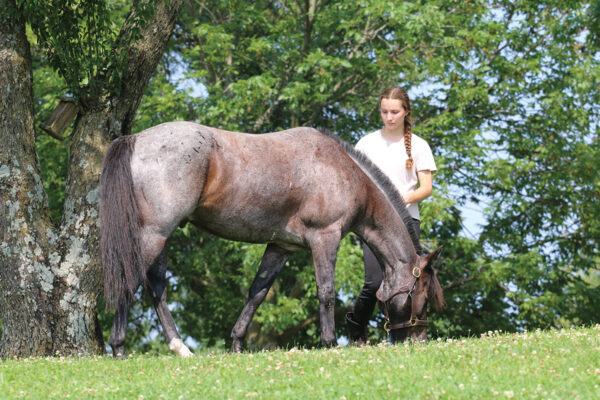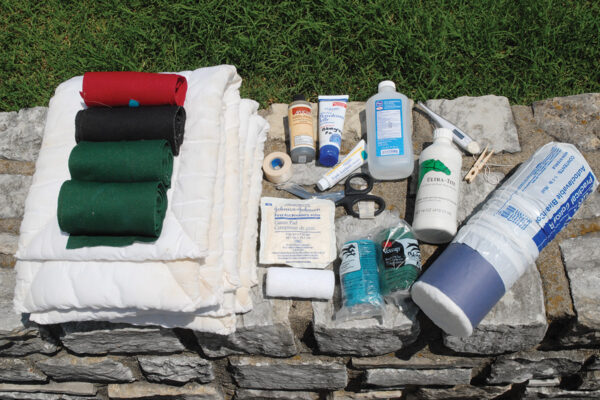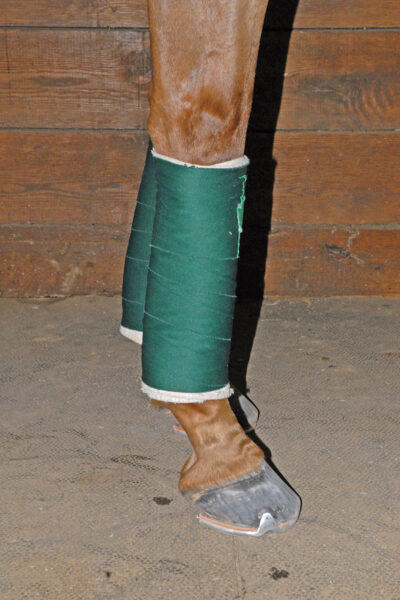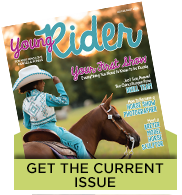
All horse owners need to have at least a basic first-aid kit in case of accidents and emergencies. It’s also important to learn how to use these items.
Purpose of Items in a Horse First-Aid Kit
◆ Make a horse more comfortable after a day of competition
◆ Assess the condition of a horse
◆ Help perform emergency first-aid on injured horses

Horse First-Aid Kit Items
Check expiration dates and note when items are low and need to be replaced. Store your kit in a container that will keep it clean and organized. It helps to store liquids and things that might leak in a zip-top bag. Continue reading for items to keep in your horse first aid kit.
Digital Thermometer
Used for taking a horse’s temperature. Digital thermometers are intended to be held in place during use. They take temperature readings quickly and usually beep when they are finished. Do not let go of it while you are taking your horse’s temperature. Clean the thermometer with soap and water or rubbing alcohol after use.
To make sure your kit is ready when needed, turn on the digital thermometer to check that the battery isn’t low. Glass thermometers are not recommended due to the health hazard created by broken mercury thermometers.
Petroleum Jelly
Primarily used to lubricate the thermometer. It can also be used on a horse’s chapped heels (from standing in mud) to protect them from wet and weather.
It’s a good idea to use rubber protective gloves or gauze squares when applying any topical product so you don’t contaminate (get germs in) the product. Using squeeze tubes reduces the chance of contamination.
Isopropyl Alcohol
Isopropyl alcohol, also known as rubbing alcohol, is used to clean and disinfect items like bandage scissors and thermometers.
Antibacterial or Antimicrobial or Antiseptic Scrub
An easy way to think about the difference between an antibacterial/antimicrobial/antibiotic “solution” and a “scrub” is that the solution treats a wound and the scrub cleans it.
A scrub can be made from an antimicrobial solution by adding a quarter to a third of the volume in liquid soap. After mixing it gently, pour a little out and see if it makes suds or at least feels slimy between your fingers. Antibacterial liquid soap is an inexpensive option for this item.
Topical Antibacterial or Antimicrobial or Antibiotic Agent for Wound Treatment
These should contain the words “antibacterial” OR “anti-microbial” OR “antibiotic” on the label/packaging. Also look for an expiration date, which indicates that it contains an active ingredient.
While the active ingredients in topical agents are effective in the treatment of wounds in horses, some of these can be hazardous to your health. Use rubber gloves or gauze squares when applying these topical agents. Human treatments of any triple antibiotic ointment are an acceptable topical agent. You would need at least 2 ounces to treat a horse.
4-inch Sterile Wound Dressings
Each dressing must be individually wrapped to be sterile. The current USPC Manual of Horsemanship, C Level recommends a minimum of four to treat a minor wound: two to clean, one to blot, then one to dress.
Stock your kit with at least eight dressings in sealed packages that say “sterile.” Additional sterile wound dressings of other sizes may be included. Replace packages that are discolored or have become unsealed.
One Roll Gauze (At Least 2 Inches Wide)
This is very helpful in keeping a gauze pad in place over a wound. Roll gauze can be the brown type that veterinarians use, or stretchy cling gauze available in grocery stores.
Two Flexible Stretch Adhesive/Cohesive Bandages (aka “Vetrap”)
These are useful in keeping a gauze pad or other wound padding in place. Apply snugly enough to keep it in place, but use caution, since it can stretch and cut off circulation.
Check to make sure they remain in useful condition. The material can break down over time and become difficult to unroll, especially if they are left in hot environments like cars or trailers. Don’t use non-self-adhesive human stretch bandages, like Ace wraps, because they stretch too much and can cut off circulation.
One Roll of 12-inch Practical Cotton
Absorbent practical cotton is used when building a bandage over a bleeding or oozing wound.
Roll cotton is multi-purpose. It can be cut or pulled apart to make small-sized pieces, saturated with Isopropyl alcohol and used like a sponge to apply to an overheated horse, cut to fit the base of a hoof to wrap as a sole pad, et cetera.
Roll cotton can be open; it does not need to be sterile, since it should not be used next to a wound.
Bandage Scissors
Bandage scissors are used to cut a bandage off a horse’s leg. The blunt tip allows the scissors to cut close to the skin without cutting into it. Never use regular scissors with sharp points or even children’s school scissors to remove a bandage.
One-Roll Bandage Tape (1-inch Width)
Adhesive tape keeps a gauze pad or other wound padding in place. This tape is specifically designed to hold bandages on. It’s also known as cloth sports tape or bandage tape.
Four Leg Bandages with Appropriate Padding for Four (4) Stable Wraps
These can be applied over treated leg wounds. Remember to bandage the adjacent leg to provide support.

The bandaging materials listed here are geared toward the treatment of various emergency leg wounds, with the worst injury being a traumatic leg wound that requires blood stoppage.
Bandages
Track bandages, flannel bandages, or knit bandages with Velcro closures. Polo wraps are too stretchy and should not be used for stable wraps.
Building a Bandage with Horse First-Aid Kit Materials
In building a bandage from the items in your equine first-aid kit, the first layer against a wound should be 4″ sterile wound dressings (gauze pads or non-stick pads) and roll gauze.
Over this sterile layer, apply a layer of practical cotton (sterile or non-sterile) or other cotton padding. Then use a leg wrap to hold it all in place.
Padding
You will need the correct size to fit your horse. Padding must be soft, smooth, and thick enough to distribute pressure evenly without binding or causing too much pressure on any structure of the leg.
Common types of padding may be referred to as quilts, pillow wraps or no-bows. Sheet cotton can also be used. Padding should be clean and in good condition.
Liniment
Liniments may be used on horses following exercise to help reduce pain and swelling, applied either by rubbing on full-strength, especially on the legs, or applied in a diluted form, usually added to a bucket of water and sponged on the body.
Liniment is also useful in hot weather to help cool down a horse after working. The alcohol cools through rapid evaporation, and counterirritant oils dilate capillaries in the skin, increasing the amount of blood releasing heat from the body.
Horse First-Aid Kit Brought to You by United States Pony Clubs
This article was brought to you in partnership with the United States Pony Clubs, Inc. Join Pony Club for more lessons like this! Find a Pony Club or Pony Club Riding Center near you and learn more at www.ponyclub.org.
This article about assembling a horse first-aid kit appeared in the March/April 2022 issue of Young Rider magazine. Click here to subscribe!


